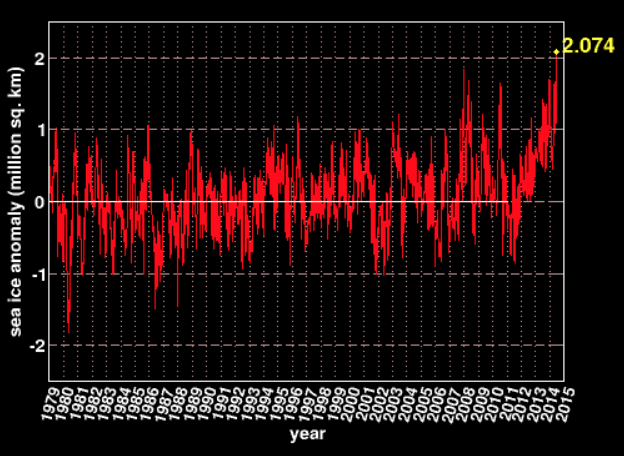The new record anomaly for Southern Hemisphere sea ice, the ice encircling the southernmost continent, is 2.074 million square kilometers and was posted for the first time by the University of Illinois at Urbana-Champaign's The Cryosphere Today early Sunday morning.
It was not immediately apparent whether the record had occurred on Friday or Saturday. Requests for comment to Bill Chapman, who runs The Cryosphere Today, were not immediately returned.
The previous record anomaly for Southern Hemisphere sea ice area was 1.840 million square kilometers and occurred on December 20, 2007.
Global sea ice area, as of Sunday morning, stood at 0.991 million square kilometers above average. (The figure was arrived at by adding the Northern Hemisphere anomaly and the Southern Hemisphere anomaly. A graph provided by The Cryosphere Today showed the global anomaly as 1.005 million square kilometers.)
Although early computer models predicted a diminishment of both Northern Hemisphere and Southern Hemisphere sea ice due to anthropogenic global warming, subsequent modeling has posited that the results of warming around Antarctica would, counter-intuitively, generate sea ice growth.
A freshening of the waters surrounding the southernmost continent as well as the strengthening of the winds circling it were both theorized as explanations for the steady growth of Antarctica's sea ice during the period of satellite measurement.
A number of prominent climatologists have discounted the growth of Antarctic sea ice, arguing that it is less significant to global circulation than ice in the Arctic basin.
Walt Meier, formerly of the National Snow and Ice Data Center and currently of NASA's Goddard Institute for Space Studies, has previously said that Antarctic sea ice, which has little ice that survives year to year, is less significant than Arctic sea ice to the climate system.
"While the Arctic has seen large decreases through the year in all sectors, the Antarctic has a very regional signal - with highs in some areas and lows in others," Meier said in 2013. "And of course, the Arctic volume is decreasing substantially through the loss of old ice. The Antarctic, which has very little old ice, hasn't much of a volume change, relatively speaking."
The new Antarctic record anomaly was more than 10 percent greater than the previous record.
The steady growth of Antarctic sea ice and its influence on global sea ice appeared to provide a public relations problem, at a minimum, for those warning of global warming's menace. According to Meier and some other climatologists, global sea ice area is simply not a metric to consider when examining the climate system.
"A plot of global sea ice is just not informative or useful," Meier said.Global sea ice, during the course of the last year and a half, has seen its most robust 18-month period of the last 13 years, maintaining, on average, a positive anomaly for an 18-month period for the first time since 2001.
Phil Jones, of the Climatic Research Unit at the University of East Anglia, waded into the global sea ice analysis in 2013 as well.
"Adding the Arctic and Antarctic sea ice extents doesn't make that much sense as the two regions are at opposite ends of the world, and the seasons are opposite," Jones said at the time.
As I also reported in Don't Sell Your Coat, the temperature at the South Pole has been declining during the past four decades as well.




Where do you dig up these people with zero educational qualifications to be making statements about the climate? A "lifelong environmentalist" is a hilariously bullshit professional title.
Sea ice and land ice are not the same thing.
Over the past 30 years:
Arctic Ice Mass is decreasing exponentially and is down 30%
Arctic Ice Volume is decreasing exponentially and is down 30%
Arctic Ice Area is decreasing exponentially and is down 40%
Antarctic Ice Mass is decreasing exponentially and is down 50%
Antarctic Ice Volume is decreasing exponentially and is down 50%
The glaciers are melting (land ice) faster than this sea ice is growing.